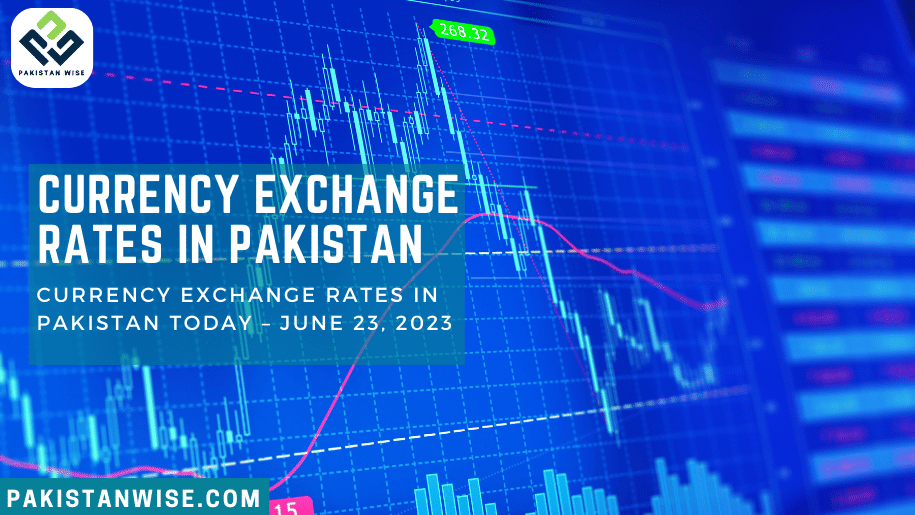Foreign currency exchange rates play a crucial role in international trade and finance, influencing the value of a nation’s currency against others. In Pakistan, the exchange rates of major foreign currencies, including the US Dollar, UK Pound Sterling, European Euro, UAE Dirham, Saudi Riyal, and others, are constantly fluctuating in the local open market. Understanding these rates is essential for individuals and businesses engaging in foreign transactions. In this article, we will provide an in-depth analysis of the exchange rates in Pakistan’s open market, exploring factors that influence them and shedding light on their importance.
Fluctuating Exchange Rates in Pakistan
As of Friday, June 23, 2023, the exchange rate of one US Dollar against the Pakistani Rupee stood at Rs 289 for buying and Rs 291.5 for selling purposes. However, it’s important to note that these rates are subject to variation based on the specific location and the exchange company or bank involved in the transaction. Therefore, it is advisable to consult with authorized foreign exchange dealers or financial institutions for real-time rates.
| Buying | Selling | ||
| US Dollar | USD | 289 | 291.5 |
| Euro | EUR | 317.5 | 320.5 |
| UK Pound Sterling | GBP | 369 | 372 |
| U.A.E Dirham | AED | 80.2 | 81 |
| Saudi Riyal | SAR | 76.3 | 77 |
| Australian Dollar | AUD | 202 | 204 |
| Bahrain Dinar | BHD | 763.63 | 771.63 |
| Canadian Dollar | CAD | 226 | 228 |
| China Yuan | CNY | 40.28 | 40.58 |
| Danish Krone | DKK | 41.16 | 41.56 |
| Hong Kong Dollar | HKD | 36.6 | 36.95 |
| Indian Rupee | IND | 3.48 | 3.58 |
| Japanese Yen | JPY | 2 | 2.08 |
| Kuwaiti Dinar | KWD | 934.05 | 943.05 |
| Malaysian Ringgit | MYR | 62.42 | 63.02 |
| New Zealand Dollar | NZD | 179.06 | 181.06 |
| Norwegians Krone | NOK | 25.67 | 25.97 |
| Omani Riyal | OMR | 740.5 | 748.5 |
| Qatari Riyal | QAR | 78.37 | 79.07 |
| Singapore Dollar | SGD | 218 | 220 |
| Swedish Korona | SEK | 26.36 | 26.66 |
| Swiss Franc | CHF | 314.07 | 316.57 |
| Thai Bhat | THB | 8.21 | 8.36 |
Factors Influencing Exchange Rates
Exchange rates are determined by the interplay of various economic factors and market forces. Here are some key factors that influence foreign currency exchange rates in Pakistan:
- Supply and Demand: The fundamental principle driving exchange rates is the balance between the supply and demand of foreign currencies. When the demand for a particular currency increases, its value tends to rise, leading to a higher exchange rate. Conversely, if the demand decreases, the currency’s value depreciates, resulting in a lower exchange rate.
- Inflation Rates: Disparities in inflation rates between countries can affect exchange rates. If a country experiences higher inflation than its trading partners, its currency’s purchasing power declines, leading to a lower exchange rate.
- Interest Rates: Divergence in interest rates influences exchange rates as well. Higher interest rates attract foreign investors, driving up demand for the currency and increasing its value. Conversely, lower interest rates may discourage foreign investment and result in a lower exchange rate.
- Political Stability: Political stability is a crucial factor in determining exchange rates. Countries with stable political environments often attract foreign investment, strengthening their currency’s value. On the other hand, political unrest or uncertainty can lead to a depreciation of the currency.
- Economic Performance: A country’s economic performance, including indicators like GDP growth, trade balance, and employment rates, has a significant impact on its exchange rates. Strong economic performance generally leads to a stronger currency and higher exchange rates.
Monitoring Currency Exchange Rates in Pakistan
To keep track of the ever-changing exchange rates in Pakistan, it is important to be aware of reliable sources that provide up-to-date information. Several financial institutions, exchange companies, and online platforms offer real-time exchange rate data. It is advisable to choose reputable sources to ensure accurate and reliable information.
Conclusion
Understanding foreign currency exchange rates in Pakistan is essential for individuals and businesses involved in international trade and finance. In Pakistan’s open market, the exchange rates for major currencies fluctuate based on supply and demand dynamics, economic factors, and market forces. By keeping an eye on these rates and staying informed about the factors that influence them, individuals and businesses can make well-informed decisions regarding their foreign transactions. Remember to consult authorized dealers or financial institutions for the most accurate and up-to-date exchange rate information.

